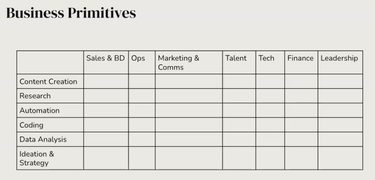
Draw the Bow: What the Stoic Archer Teaches Us About AI


There’s no shortage of talk about AI these days. From the nightly event lineup in San Francisco to the endless stream of LinkedIn posts, newsletters, quarterly reports, and hot takes, the noise can be overwhelming. But amidst the hype, speculation, and grand proclamations, it’s clear that this moment is real and it matters.
We’re in the early innings of what will likely be one of the most consequential shifts in how businesses are built, operated, and scaled. In my view, the magnitude of this moment is bigger than the move from analog to digital, and it will take place at a faster pace. But unlike past transitions, the bottleneck today isn’t the technology. It’s us and the organizational structures we have built.
For years, software was something you had to hire for, spec out, and build from scratch. You needed engineers, PMs, and timelines. AI changes that. With today’s tools, you can tell the software what to do — no code required. It’s not perfect, but the pace of change is accelerating and will reward those leaning in. This has fundamentally changed the barrier to innovation, and I believe that now the real challenge is one of mindset (and willingness to make the change), not mechanics.
Just Start Pulling the Bow
At S2G, we’ve been encouraging our portfolio companies to stop chasing the perfect strategy and just start pulling the bow. Launch a pilot. Run a test. Try something new. Like an archer learning to draw for the first time, it’s not about hitting the bullseye right away. It’s about getting comfortable with the pull.
We recently launched a monthly roundtable series for our portfolio companies in partnership with my longtime friend and advisor, Justin Massa, focused on practical AI implementation. The goal is to create space for shared learning, real-world experimentation, and beneficial failure. Through our first session, we heard powerful examples of companies that aren’t AI-native but are already rethinking everything from BD to marketing to operations.
Justin introduced a helpful framework grounded in what OpenAI calls the six business primitives: content creation, research, automation, coding, data analysis, and ideation. He expanded that lens to explore how those primitives can be applied across key business functions, from sales and marketing to finance, talent, and leadership itself.

The through line? Start small (fail small). We’re encouraging teams to launch AI pilots that can show measurable ROI within 90 days. Not just to check a box, but to build confidence and capability. It’s about developing the organizational muscle to adapt and scale AI as a competitive advantage, not a shiny object. No warrior is a master of the bow, with a few shots or by watching a youtube video. No one is an expert at AI yet.
One idea we discussed was piloting AI to create customized 10-minute podcasts tailored to each prospective customer. By uploading data on the customer’s goals as stated in their annual report or press releases and matching it against a company’s own solution set, they can build an automated, multimodal sales asset that meets prospects with relevance. Would it work for everyone? Maybe not. But the test itself is the win.
Another company is using generative AI to surface insights about regional logistics delays, helping explain a revenue miss in near real time, which is something that would’ve previously taken hours of dashboard diving. These aren’t moonshots. They’re practical plays that improve speed, visibility, and decision-making.
We also heard from teams wrestling with questions around implementation and organizational readiness. AI doesn’t have to be a top-down mandate or an enterprise-wide overhaul. In fact, the best strategies we’ve seen start small and scale deliberately. Think focused use cases, cross-functional champions, and clear feedback loops, with reasonable adoption cadences.
Be Mindful of Mindset
In my view, the mindset shift is the biggest lift. AI is a capability, not just a tool. And building that capability means approaching it like you would any other core function in your business: with intention, iteration, and clarity of purpose. We are nowhere near understanding the limits of it’s capabilities.
As someone who saw the rise of the internet firsthand while building OpenTable, I can tell you the companies that win in these moments aren’t always the ones with the most money or the best tech. They’re the ones who learn fastest, adapt quickly, and stay grounded in what really moves the needle for their customers and services them in ways existing solutions can’t.
We believe the same will be true in this wave. The archer who keeps pulling the bow — who develops the habit, builds the muscle, and finds their rhythm — is the one who eventually hits the mark. Let’s keep pulling.


